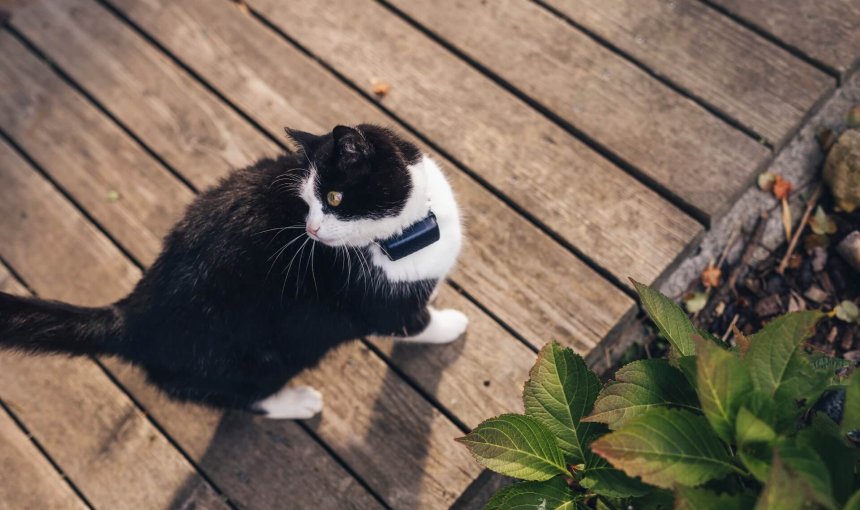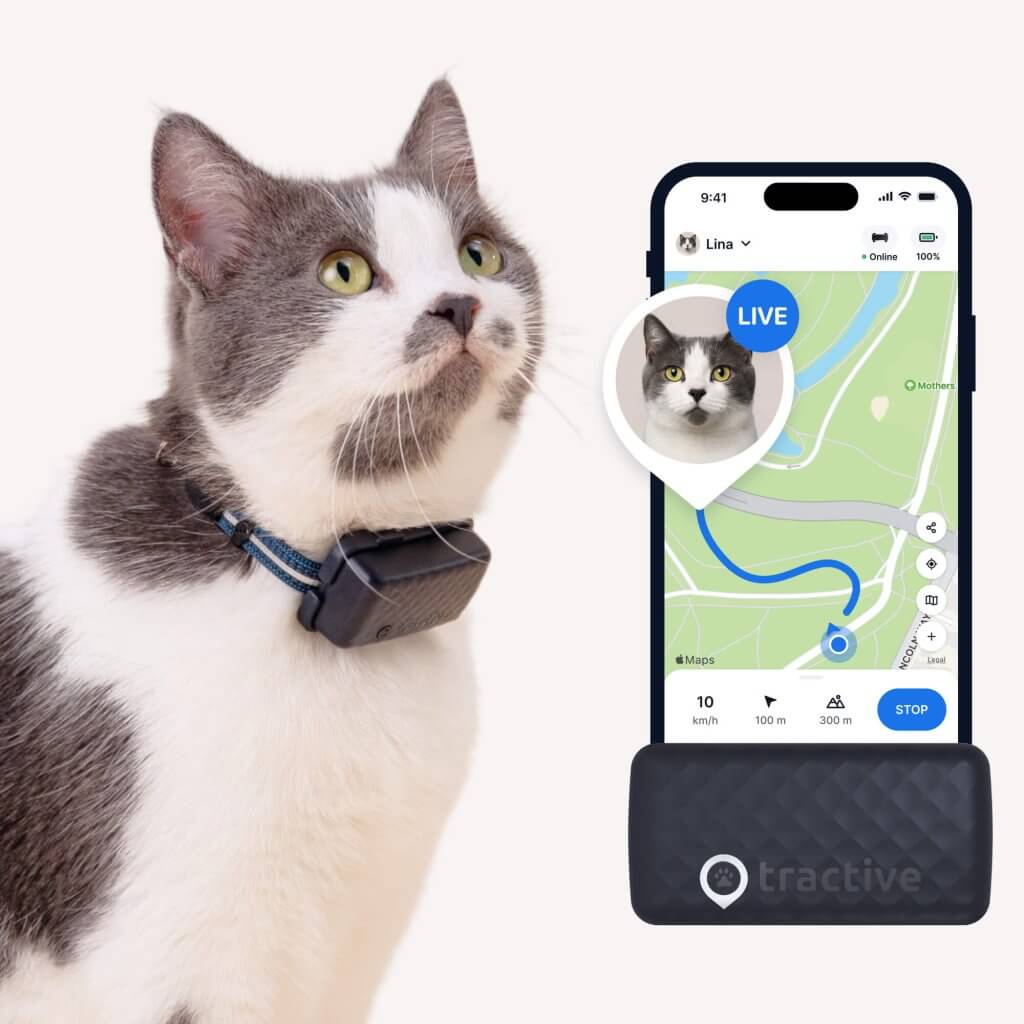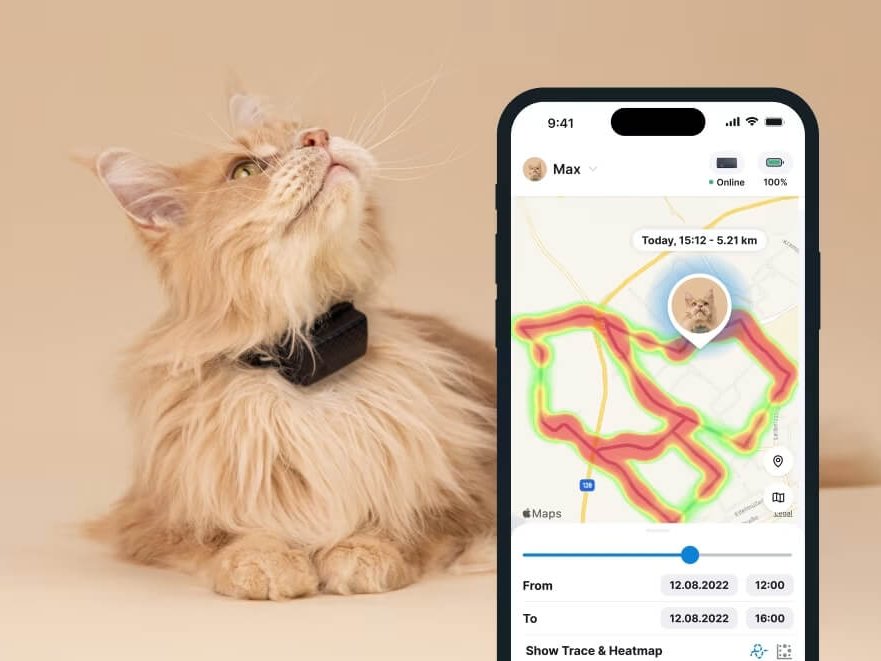Should I Let My Cat Outside? What To Consider
Deciding to let your cat outside (or not) - and how you go about it - is an important decision that will affect your cat's quality of life and wellbeing. Here's what to consider before letting your cat outside - including how to follow their every step.

Whether you’ve got an indoor cat or an outdoor cat – they’ll want to venture outdoors someday. (Yes, even your couch cat-tato next to you right now.) But the minute you start to think of the big, scary, beautiful world outside your front door, you might find yourself wondering…should I let my cat outside?
Un this guide, you’ll find information about indoor vs outdoor cats and pros and cons of both feline lifestyles. Plus, the best way to keep your indoor, outdoor, or indoor/outdoor cat safe – no matter how far they roam.

Find out where your cat spends their time.
Read more- Should I let my cat outside?
- What to consider before letting your cat outside
- When should I let my cat outside?
- Why should I let my cat go outside? The perks of being an outdoor cat
- The risks of letting your cat outside
- The perks of being an indoor cat
- The downsides of being an indoor cat
- Letting your cat outside for the first time: Tips for success
- What to do during your cat’s first outdoor adventures
- How to figure out your cat’s favorite hangout spots
- Alternatives to giving your cat unlimited access to the outdoors
- So…should I let my cat outside?
Should I let my cat outside?
Yes – if you can ensure their safety. In fact, most cats want to be outdoors! They may pounce out the front door every chance they get, or look longingly out the window. And it’s no surprise; our domesticated kitties come from a long line of felines who thrived outdoors in the wild.
Being cooped up indoors all the time isn’t healthy for your cat. They’ll love the exercise, sunlight, and sensory stimulation from the sights, sounds, and smells of nature with some outdoors time.
On the other hand, the outdoors can also be dangerous for cats. From other cats, larger animals, predators, poisonous plants, pesticides, pet thieves, passing vehicles…there’s no end to the threats your cat might face if they wander off too far from home and get lost.
But does that mean you should let your cat outside? Here are a couple of steps to consider beforehand.
What to consider before letting your cat outside
- Age
Is your cat old enough to go outside? A newborn kitten might be too young to go outdoors. Or an elderly cat with dementia might be better kept indoors or in a fenced-in yard. - Health
Do they have all their vaccinations? Is your cat in good enough health to be let outdoors? - Environment
Is your outdoor space – and the surrounding area – safe for cats? Make sure to check that it’s not too hot nor too cold for them to stay outdoors for too long. - Laws
Are there any laws governing free-roaming cats in your area? For example, most countries around the world require all pets to be microchipped and registered in a national database at the very least. - Temperament
Does your cat want to go outside? In some cases, it might not be the best idea. (Like if they’re very young – or on the older side.) - Your cat’s experiences
For example, if you’ve just adopted a stray cat, chances are your feline friend loves being outdoors. (Because they’ve likely gotten used to it.) But if your cat has a traumatic history – they may feel scared going outside and prefer to stay indoors. - Reproductive status
Intact girl cats in heat might paw against the door to be let outside when they’re ready to find the purr-fect mate. Or an intact boy cat might want to sneak outdoors because they’ve sniffed out a female in heat.
💡A cat GPS tracker can be an important emergency measure to track down your cat in case they go missing. With just a glance at your phone, you can track your cat in real-time, over an unlimited range, and without needing a network of devices to help. (Like you’ll find with an AirTag.)

Track your cat wherever they go
Get real-time location information, wherever they go. Find out when they go somewhere they shouldn’t, with Virtual Fences. And discover their favorite spots with Territory.
When should I let my cat outside?
If you just got a new adult cat, it’s best to give them some time to get used your home before letting them go outside. A good rule of thumb is to wait 2-6 weeks before letting a new adult cat outdoors. After all, cats are territorial, so they’ll need time to map and adjust to their new territory.
⚠️ When it comes to kittens, wait until they are at least 4-5 months old before letting them venture into the great outdoors. You should also make sure your cat is vaccinated, microchipped and neutered before letting them roam outdoors.
Why should I let my cat go outside? The perks of being an outdoor cat
Outdoor cats typically thrive with the fresh air, enrichment, and physical activity that comes with free access to the great outdoors. Your cat can enjoy engaging in their natural, instinctive feline behaviors – like scratching or stalking prey. (Aka, no more shredded curtains or carpets.) This also means more opportunities to run, climb and explore. Which means fewer health issues in the long run.
In short, your cat can enjoy their feline life to the fullest when they’re allowed safe outdoor access.
The risks of letting your cat outside
Letting a cat outdoors can do wonders for their happiness and wellbeing. But the decision also comes with some potential downsides. For example, your wandering cat might end up getting:
- Injured by a passing vehicle or another animal
- Infected with a disease or allergy or parasite, like ticks or ear mites,
- Poisoned by a plant that’s toxic to them or other harmful substances, including certain foods
- Stuck or trapped somewhere (like a car, or a neighbor’s shed)
- Stolen by pet thieves
The perks of being an indoor cat
Indoor cats tend to be better protected from the dangers outdoor cats face. So they’re generally safer – plus you pretty much always know where they are. This is actually why indoor cats usually live longer than outdoor cats1. On average, your indoor cat might live a long, leisurely life of around 10-20 years by your side. Outdoor cats, on the other hand, might only live around 2-5 years.
With all that said – doesn’t it make perfect sense to just…keep your cat indoors all day? After all, it’s ideal for their safety, right? Nope, not quite.
The downsides of being an indoor cat
Despite the benefits, indoor cats face some risks too. I.e., a less active lifestyle (and less stimulation overall). Which, over time, could lead to health issues. – both physical and mental. Cats who don’t have outdoor access will typically have fewer opportunities to explore, play, roam and engage in their natural cat activities. Which means, if they’re cooped up indoors all day, they’re likely to experience:
- Boredom
- Depression
- Separation anxiety
- Obesity and other weight-related health issues (including diabetes and heart disease)
- Stress
Letting your cat outside for the first time: Tips for success
Here are some best practices and tips for letting your cat outside safely – if you’re doing it for the first time ever. Before letting your cat go outdoors, make sure to do the following:
- Microchip your cat to ensure they can be identified if lost and brought into a vet or shelter.
- Equip your cat with a quick-release, safety collar and and an ID tag with your contact details – so you can be contacted in case they’re found missing or injured.
- Make sure your cat has had all of the recommended vaccinations for outdoor cats – and that they’re up to date.
- Get your cat fixed. This will prevent them from becoming a nuisance at your neighbors’ who have female cats.
- Make your backyard or garden cat-friendly – remove any poisonous plants or other toxic substances.
- Sprinkle some of their used litter around the perimeter of your yard – to help them establish their new territory.
- Take a good photo of your cat in case you need to make a lost cat poster.
- Make sure your cat can recognize their name and train them to come to you when you call it.
What to do during your cat’s first outdoor adventures
For their first few outdoor adventures, it’s a good idea to go with them and supervise your cat. Leave the door open so your cat can return inside if they want to. Let your cat explore the new outdoor area undisturbed if possible.
Call your cat back when you feel like they’ve wandered too far – and reward them for doing so. Let your cat roam again sometimes after receiving a reward, so they don’t always associate coming when called with going inside. Gradually increase the length of time your cat is outside over a few days/sessions.
Next, make a routine out of it – your cat can learn when it’s time to go outside and when it’s time to come back in. Once your cat seems comfortable being outside, let them come and go without you.
Always try to let your cat back indoors immediately when they show signs of wanting to be back inside. Consider installing a cat flap to give your kitty true independence.
Read more: How to Train A Cat To Go Outside (And Come Back)
How to figure out your cat’s favorite hangout spots
As you let your cat outdoors more often, you’ll start to notice they have a bunch of favorite hiding, hunting, and hanging out spots. (Maybe a nearby barn or a patch of woodland full of mice or that one spot under your porch.) This can actually help you find your cat easier if they disappear for longer than usual. I.e., if you’re suspecting your cat is missing, you could start by checking their favorite spots first – and then widen your search, if necessary.
💡Which is where Tractive’s Heat Map and Location History comes in handy.

With just a glance at your phone, you can figure out where your cat likes to spend most of their time during the day. And if they ever go missing, you now know where to look first.
Besides their Location History, you can also:
- Follow your cat’s every step in real-time – with LIVE tracking
- Get an escape alert if your cat leaves a “safe zone”
- Share your cat’s LIVE location with family and friends if they do go missing
- Locate your cat at close distances with your tracker’s Bluetooth-powered Radar Mode
All this in one device – built with love for cats and for your peace of mind as a cat parent.
Alternatives to giving your cat unlimited access to the outdoors
Some cat parents want to give their cats the benefits of the great outdoors, while keeping them protected from the potential dangers. If this is you, you can try these options to give your cat safe, limited outdoor access:
- Train your cat to walk on a leash with a harness.
- Cat-proof your balcony for your feline to enjoy.
- Build your cat a catio – they’ll be entertained (and safe) for hours!
So…should I let my cat outside?
Yes – provided you can guarantee their safety. Because when it comes to us hoomans and our cats, no two individuals are the same. Factors like your cat’s age, health, environment – and how you can shield them from the dangers they might face outside – all play a role.
Both indoor and outdoor cats can live happy, healthy lives – but it’s your responsibility as a pet parent to ensure they have everything they need to do so. That means keeping them safe if they do go outdoors.
“Anyone with cats knows how slick they are…even if your cat is an indoor cat, they will eventually find a way out.
My cat is indoor and outdoor, and I will never again have a cat without a Tractive! First, it’s fascinating seeing where they go, their favorite spots, and the territory they establish.
Second, when she has been out too long and I start to worry, I know right where she is and I go get her! I would recommend this highly for both cats and dogs!“
– Traci, US (Source: Trustpilot)



